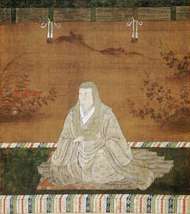Nene (aristocrat)

Nene (ねね, 1546–1624), also known as One (おね) or Nei (ねい) or Nemoji or Kōdai-in (高台院) or Toyotomi Yoshiko. Her childhood name was Sugihara Yasuko (杉原 寧子). She was the principal samurai wife of Toyotomi Hideyoshi.[1] She is also known by the title of "Kita no mandokoro".
Early life
She was born in about 1546. She was the daughter of Sugihara Sadatoshi. It has been rumored that Toshiie Maeda held some romantic interest in Nene prior to her marriage.
Hideyoshi's wife
In about 1561, she married Hashiba Hideyoshi, a man who would later become one of the three great unifiers of Japan, although at the time of their marriage he had yet to gain much fame. Nene was his principal wife and also one of his favorite wives. In 1585, after Hideyoshi was appointed to the post of Imperial Regent (Kampaku), Nene took on the title of "Kita no mandokoro", by which she is most commonly known in English.
As the wife of Hideyoshi, Nene is most famous for being one of his closest aides and confidantes. The daughter of a samurai, she had many familial connections that netted Hideyoshi several retainers. Among these retainers were Sugihara Ietsugu (Nene's uncle), Kinoshita Iesada (Nene's brother), Kobayakawa Hideaki (Nene's nephew) and Asano Nagamasa (Nene's brother-in-law). The last of these characters would serve as an important official in Hideyoshi's later administration. Nene was known to have been an intelligent woman who, at times, advised Hideyoshi on matters of governance by sending him letters. When Hideyoshi repealed the tax exemptions he had granted to the residents living in his headquarters at Nagahama, Nene appealed to him to reinstate the exemptions, and he did. It is also recorded that Hideyoshi frequently wrote letters to Nene to tell her about how his campaigns were going. Hideyoshi did this after his invasion of Sassa Narimasa's territory in Japan's Hokuriku region and after his campaign against the Shimazu clan.
When Hideyoshi unified Japan, Nene often went with him to attend parties. She was courteous and respectful to her guests on every occasion. When Emperor Go-Yozei visited Hideyoshi's mansion with his entourage in 1588, Nene freely distributed a plethora of gifts to Hideyoshi's visitors. Nene worried about Hideyoshi often when he was on his deathbed. Eventually, as Hideyoshi was on his last throes, she even petitioned the Imperial Court to sponsor a sacred dance ritual to pray for and expedite Hideyoshi's recovery.
Though adored, Nene often found herself competing with other women for Hideyoshi's attention. In a letter to Nene, Oda Nobunaga also noted that Hideyoshi was somewhat dissatisfied with Nene. Hideyoshi took up several concubines. Nene did not bear any children.[1]
Letter from Oda Nobunaga
...It has been quite sometime since I last saw you, but your beauty grows day by day. Tokichiro [Hideyoshi] complains about you constantly and it is outrageous. While that "bald rat" [Hideyoshi] flusters to find another good woman, you remain lofty and elegant. Do not be envious. Show Hideyoshi this letter...
Hideyoshi's widow
After Hideyoshi died in 1598, Nene became a nun, taking the name Kōdai-in (高台院) and establishing a Buddhist temple, Kōdai-ji, in Kyoto, to which she moved. It became the burial area for her husband, his mother, and later Toyotomi Hideyori. During the contest between Toyotomi Hideyori and Tokugawa Ieyasu for supremacy, Nene took the side of Ieyasu.
Legacy
After her death in 1624 she was posthumously given the name of Hikari no Tenshi or "Angel of Light" and entombed at the Hikari no Shrine in Kyoto.[2]
The life of this prominent resident of Kyoto is still commemorated in a short street which bears her name. Nene's Street (ねねの道 Nene-no-Michi) remains lined with structures built in traditional Kyoto style. Nene-no-Michi is located in Higashiyama Ward in eastern Kyoto near Kōdai-ji, Maruyama Park and Yasaka Shrine.[3]
Honours
- Junior First Rank (April 19, 1588)
See also
People of the Sengoku period in popular culture.
References
- 1 2 Nussbaum, Louis-Frédéric. (2005). "Matsudaira Ietada" in Japan Encyclopedia, p. 702.
- ↑ Nenzi, Laura. (2008). Excursions in Identity: Travel and the Intersection of Place, Gender, and Status in Edo Japan, p. 89.
- ↑ Rowthorn, Chris. (2005). Kyoto: City Guide, p. 95; JapanVisitors: Kodaiji Temple/Nene-no-Michi.
Further reading
- Berry, Mary Elizabeth. (1982). Hideyoshi. Cambridge: Harvard University Press. ISBN 978-0-674-39025-6
- Nenz Detto Nenzi, Laura. (2008). Excursions in Identity: Travel and the Intersection of Place, Gender, and Status in Edo Japan. Honolulu: University of Hawai'i Press. ISBN 978-0-8248-3117-2
- Rowthorn, Chris. (2005). Kyoto: City Guide. Melbourne: Lonely Planet. ISBN 978-1-74104-085-2 OCLC: 224361206
- Yoshikawa, Eiji. (1992). Taiko: An Epic Novel of War and Glory in Feudal Japan. Tokyo: Kodansha International. ISBN 978-4-7700-1570-9 (cloth)
- _________. (2000). Taiko: An Epic Novel of War and Glory in Feudal Japan. Tokyo: Kodansha International. ISBN 978-4-7700-2609-5 (cloth)